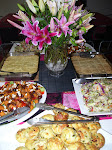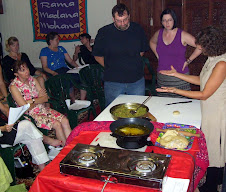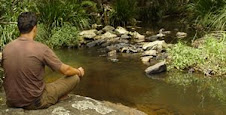
In a previous post, we discussed the origin of chutneys and how you can dress up a dhal or curry with a good chutney. We also gave some tips on other ways of serving chutneys, such as as a dip platter with a variety of chutneys, sour cream or natural yoghurt and chapatis or naan bread. In this post we will give some tips on they equipment needed for making chutneys and some ideas on adding flavours and preserving chutneys. I'll also be giving you a delicious chutney recipe.
Equipment needed:• A stainless steel or enamel-lined pan that is large enough to contain all the ingredients (if you’re also a big jam maker it may be well worth in investing in a preserving pan). Brass, copper or iron pans should not be used as they react with the vinegar and give a metallic flavour to the chutney.
• Long-handled wooden spoon – this should be reserved for chutney-making only as the wood becomes impregnated with the spiciness of the chutney and will taint other recipes.
• Sieves – stainless steel or nylon
• Heatproof jug or wide necked stainless steel funnel - a heatproof glass, stainless steel or enamel jug is useful for pouring the chutney into the jars. Alternatively a wide necked stainless steel funnel or a large ladle can be used.
• Muslin or cotton squares – to tie up whole spices wanted for flavourings.
• Scales – preferably dual marked in metric and imperial.
• Chopping boards and stainless steel knife.
• Heat proof jars of assorted sizes. These should be clean, dry, sterilized and warm before pouring in the chutney. To sterilize the jars just before filling, put into a "cool" oven, 140°C.
• Covers – these are most important. Vinegar corrodes metal, so use plastic screw or snap-on type or plastic preserving skin. Specialist preserving or bottling jars are suitable, either with screw-on or clip-on lid, providing the lid is made of glass.
• Labels – For the front of the jars to identify the chutney and the date made.
Kerala Mango Achar (Mango chutney)
- Mangoes-2 Cut into small square pieces
- chilli pwd-4 T
- salt-3T
- Asafoetida-1/2 teaspoon
- Turmeric pwd-1 teaspoon
- Mustard seeds-1/2 teaspoon
- Oil -1 T
Heat oil in a pan.
To that add mustard seeds.
When it pops reduce heat to low and add chilli pwd, salt, asafoetida, turmeric and stir for about 3 min.
Turn off the heat.
Let it cool for a while.
Add this mixture to the cut mangoes and mix thoroughly.
Keep this for 7-8 days for the flavour to seep into mangoes.
You can add a little bit of distilled vinegar if you like.It will help to keep the freshness.
Gayatri
Instructor
Australian School of Meditation and Yoga

















